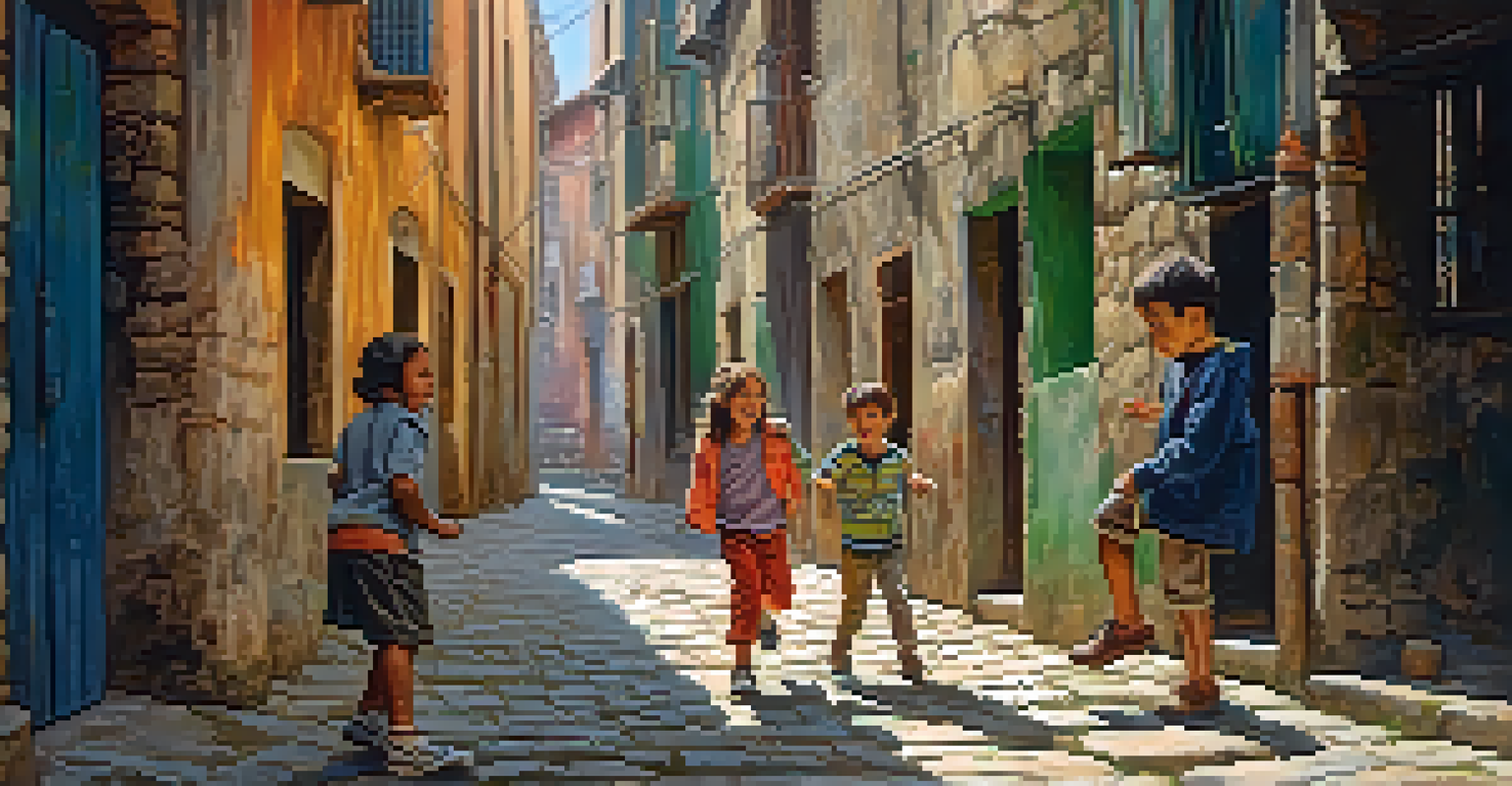Italian Neorealism: Capturing Life Through Raw Storytelling

What is Italian Neorealism? A Brief Overview
Italian Neorealism emerged in the 1940s as a response to the devastation of World War II. This film movement focused on depicting everyday life, especially the struggles of the working class. Unlike the glamorous productions of the time, Neorealism sought authenticity through real locations, non-professional actors, and relatable stories.
Neorealism is a film movement that reflects the reality of life in a way that is both deeply personal and broadly universal.
The movement was not just an artistic choice but a cultural necessity, aiming to reflect the harsh realities faced by Italians. By portraying real-life challenges, filmmakers aimed to evoke empathy and provoke thought among audiences. This approach was revolutionary, breaking away from the escapism prevalent in cinema before the war.
Key directors like Roberto Rossellini, Luchino Visconti, and Vittorio De Sica were instrumental in shaping this style. Their films often depicted themes of poverty, family struggles, and social injustice, laying bare the human condition. Through their storytelling, they invited viewers to connect deeply with the characters and their experiences.
The Historical Context of Neorealism
To understand Italian Neorealism, it's essential to consider the historical backdrop. Post-World War II Italy was marked by devastation, economic hardship, and social upheaval, with many people struggling to rebuild their lives. This environment fostered a need for storytelling that resonated with the collective experience of loss and resilience.

Filmmakers sought to break free from the constraints of fascist propaganda that dominated the previous era. They aimed to create a cinema that portrayed genuine human emotions and societal issues, reflecting the true spirit of the people. This desire for authenticity was a driving force behind the Neorealist movement.
Authenticity in Neorealism
Italian Neorealism emphasized genuine storytelling by using real locations and non-professional actors to depict the struggles of everyday life.
The effects of war were not just physical but also psychological, influencing how stories were told. Directors wanted to highlight not only the struggles but also the dignity and strength of ordinary people. This focus on realism and emotional depth became a hallmark of the movement.
Key Characteristics of Neorealist Cinema
Italian Neorealism is characterized by its raw, unvarnished portrayal of life. Filmmakers often used real locations instead of studios, creating a sense of authenticity that drew viewers into the narrative. This choice allowed them to capture the essence of everyday struggles, making the stories feel relatable and genuine.
The cinema of the free man is the cinema of the human condition, and Neorealism was one of its earliest and most effective expressions.
Another hallmark of Neorealism is the use of non-professional actors. By casting everyday people in roles, directors aimed to enhance the realism of their films. This approach brought a freshness to the performances, allowing audiences to connect with the characters on a personal level.
The narratives often revolve around themes of hardship, social justice, and the human spirit's resilience. The stories are typically unsentimental, focusing on the characters' challenges without glossing over the difficulties they face. This honesty in storytelling is what sets Neorealism apart from other cinematic movements.
Influential Films and Their Impact
Some of the most iconic films of the Neorealist movement include 'Bicycle Thieves' and 'Rome, Open City.' 'Bicycle Thieves,' directed by De Sica, tells the story of a father searching for his stolen bicycle, which is crucial for his job. This simple yet profound narrative illustrates the desperation and hope of post-war life, resonating with audiences worldwide.
Similarly, 'Rome, Open City,' directed by Rossellini, captures the struggles of resistance fighters during the Nazi occupation of Rome. The film's gritty realism and compelling storytelling brought international attention to the Neorealist movement. It demonstrated the power of film as a medium for social commentary.
Cultural Reflection Post-War
The movement arose from the societal need to reflect the harsh realities faced by Italians after World War II, fostering empathy and thought-provoking narratives.
These films not only entertained but also sparked conversations about societal issues, influencing generations of filmmakers. Their impact can still be felt today, as many contemporary directors draw inspiration from the raw storytelling and authenticity that Neorealism championed.
The Influence of Neorealism on Global Cinema
Italian Neorealism did not just shape Italian cinema; its influence spread worldwide, inspiring filmmakers across different cultures. The movement encouraged directors to focus on authentic storytelling, often highlighting social issues relevant to their own societies. This global impact helped pave the way for various cinematic movements, including the French New Wave and Latin American cinema.
Filmmakers like Satyajit Ray in India and Ken Loach in the UK adopted similar principles, emphasizing realism and human emotion. They sought to reflect the realities of their respective societies, drawing parallels to the Neorealist approach. This cross-cultural exchange enriched global cinema, creating a tapestry of diverse narratives.
Moreover, the principles of Neorealism continue to resonate in modern cinema, as many contemporary films strive for authenticity. The emphasis on real-life stories and characters remains a powerful storytelling tool, showcasing the enduring legacy of this influential movement.
Neorealism's Legacy in Contemporary Film
The legacy of Italian Neorealism is evident in the works of many contemporary filmmakers. Directors like Paolo Sorrentino and Matteo Garrone have embraced the principles of realism and human struggle, weaving them into their narratives. These filmmakers often explore themes similar to those found in classic Neorealism, such as societal challenges and the human condition.
Films like 'The Great Beauty' and 'Gomorrah' highlight the complexities of modern Italian life, reflecting both the beauty and struggles of society. By maintaining a connection to Neorealism, these directors have created powerful stories that resonate with audiences today. Their works serve as a bridge between the past and present, honoring the movement's influence.
Global Influence of Neorealism
Italian Neorealism inspired filmmakers worldwide, encouraging a focus on realism and social issues that continue to resonate in contemporary cinema.
Moreover, the rise of digital filmmaking has allowed for even greater accessibility in storytelling. Independent filmmakers around the world continue to be inspired by Neorealism, adopting its raw and honest approach to depict contemporary issues. This ongoing relevance showcases how Neorealism has left an indelible mark on the film industry.
Conclusion: The Power of Raw Storytelling
In conclusion, Italian Neorealism stands as a testament to the power of raw storytelling. By focusing on the lives of ordinary people, this movement has profoundly impacted cinema and culture. Its emphasis on authenticity, emotional depth, and social consciousness resonates with audiences, reminding us of the importance of real-life narratives.
The legacy of Neorealism continues to inspire filmmakers and audiences alike, encouraging a deeper connection with the human experience. As we navigate through life’s complexities, the stories born from this movement serve as a reminder of our shared struggles and triumphs. They challenge us to reflect on our own realities and foster empathy for others.

Ultimately, Italian Neorealism has shaped not just a genre of film, but a way of seeing the world. Its influence endures, inviting us to appreciate the beauty and resilience found in everyday life and the stories that emerge from it.